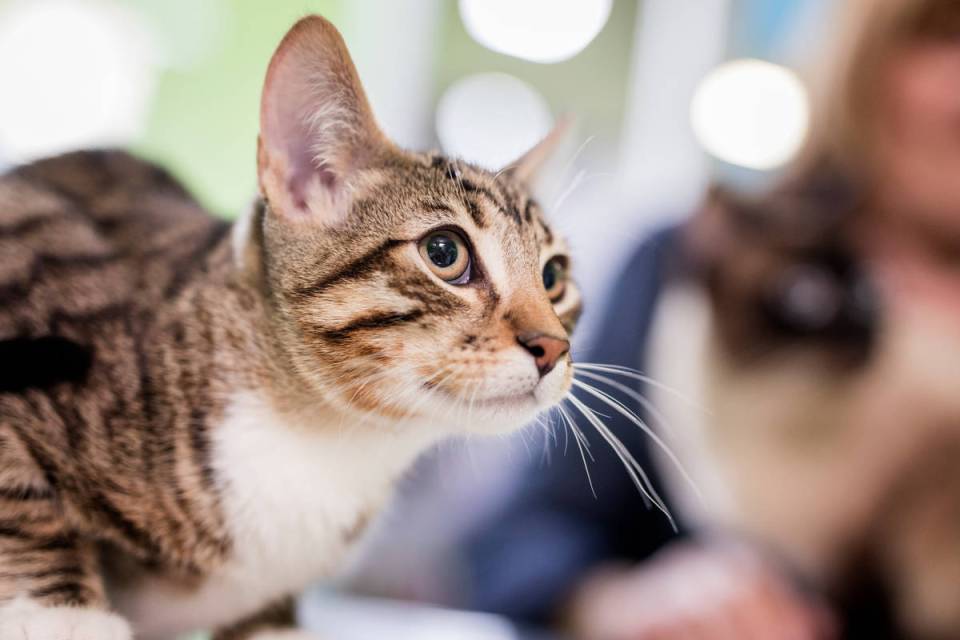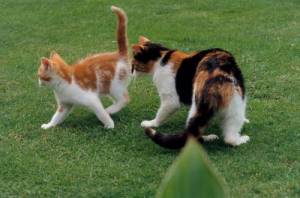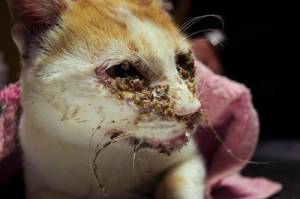
Cat Flu
Introduction
Cat flu (also known as feline upper respiratory tract disease) is a general term used to describe a common set of symptoms of the upper respiratory tract in cats. The disease may be mild, restricted to an outbreak of sneezing which improves without treatment or more severe, leaving kittens with chronic disease and can even be fatal in kittens, old cats and immunosuppressed cats. In all cases it is highly infectious spreading rapidly in a group of cats. Breeding catteries, feral colonies and cat shelters are more likely to be associated with outbreaks of disease given the large number of animals in close contact with one another, many of which may not have been vaccinated.
Aetiology
The principal causative agents are feline herpesvirus type 1 (FHV-1 ) and feline calicivirus (FCV). FCV mutates during replication resulting in many different strains of the virus which exist in the field, some of which are more pathogenic than others. Other infectious agents (e.g. Bordetella bronchiseptica, mycoplasma spp., reoviruses) can also be involved in causing similar signs of respiratory disease, but it is believed that around 80% of cases are caused by either FHV-1, FCV or a dual infection with both agents.

Epidemiology
Cats less than one year of age are most commonly affected. However, those animals that have not been vaccinated or have weakened immune systems are also susceptible. Where feline calicivirus or herpesvirus is present in a breeding environment, young kittens can easily become infected before vaccination has a chance to be effective. In this situation it is possible to see disease in young kittens despite a comprehensive vaccination policy.Virtually all cats that recover from infection with feline herpes virus remain latently infected for life, meaning that they may suffer recurrent signs at times of stress (such as a journey, a cat show, fighting with another cat or even another health problem). These cats are known as carriers and, by shedding the virus in their nasal, ocular and oral secretions, act as a source of infection for other non- vaccinated cats. Sometimes these cats can shed the virus without suffering from any clinical signs themselves. Cats infected with calicivirus, following recovery, can also continue to shed the virus for at least a month and a few continue to shed for several years, acting as a source of infection for others.FHV-1 is relatively fragile in the environment and can be killed by most household disinfectants. FCV, however, is relatively resistant to environmental conditions and can potentially survive up to a month in the environment, although in most cases probably does not survive more than 7-14 days.1Transmission of infection by FHV-1 is largely via direct contact with saliva, ocular or nasal secretions or inhalation of aerosols. During infection, the virus spreads along the sensory nerves and reaches neurons, which are the main sites of latency.With FCV, transmission of infection most commonly occurs via direct contact with saliva, ocular or nasal secretions or inhalation of aerosols. However, since the virus can easily survive for some time in the environment, transmission is also possible via infected fomites such as food bowls, litter trays, bedding and grooming equipment.

Clinical signs
There are many signs to look out for, including:• sneezing• discharge from eyes and nose• drooling• quiet and subdued behaviour• loss of appetite• high temperature• a cough or hoarse ‘miaow’• pneumonia
FHV-1 can cause a severe disease and potentially life threatening illness, especially in kittens. A less common manifestation of chronic FHV infection is conjunctivitis (inflammation of the conjunctiva) and keratitis (inflammation of the cornea). FHV infection can result in the development of multiple small branching corneal ulcers (called ‘dendritic keratitis’) which are considered diagnostic of FHV infection. Rarely, chronic FHV infection can result in skin inflammation and ulceration. This is most commonly seen around the nose and mouth, but can affect other areas such as the front legs.1FCV is usually associated with a milder form of cat flu. In kittens, it can cause lameness due to arthritis and a high temperature. This is a transient problem, usually only lasting a few days and there will often be signs of respiratory disease at the same time. In adults, sometimes the only sign of an FCV infection is painful ulcers, found on the tongue, roof of the mouth or the nose. Rarely, outbreaks of a much more serious systemic disease have been associated with particular strains of FCV, referred to as ‘virulent systemic strains. Infection with these strains can result in severe pneumonia, hepatitis, pancreatitis, skin swelling and ulceration, and bleeding from the nose and intestine. In these outbreaks up to 50% of affected cats can die.1
FCV is also thought to be associated with feline chronic gingivostomatitis (inflammation of the mouth and gums).
Diagnosis
Diagnosis can be based on:• Clinical signs- as listed above• Virus isolation- Conjunctival or oropharyngeal swabs in acutely affected cats.• Cytology or immunofluoresecent antibody testing – conjunctival scrapings for intranuclear inclusion bodies in early infection (FHV-1)• PCR to detect viral antigen. It can also detect carriers
Control
It is essential to vaccinate your cat according to your vet’s recommendations. Kittens that are born to vaccinated queens usually have antibodies from their mothers (maternal antibodies) that protect them against infection during the first few weeks of their lives. The kitten is in danger after the level of maternal antibodies declines and that is when it should be vaccinated.Cat flu vaccines will reduce the clinical signs and severity of disease caused by infection and should be given on an annual basis. Vaccines may only be prescribed by your veterinary practitioner from whom advice must be sought. Due to the ability of FCV to mutate, there are numerous strains of the virus in the field and, unfortunately, it is generally recognised that none of the existing vaccines will protect against all calicivirus strains.In a multiple cat household sick cats should be separated from others if possible. Ideally any newly introduced cat should undergo a period of strict isolation from all the other cats in the household. Swabs may be taken by the vet to screen for infection, but latent herpesvirus infections will often be missed. The quarantine period is also important because the stress of re-homing may trigger clinical disease and/or virus shedding in a cat that carries herpes virus.
Breeding queens that become persistent carriers of infection are likely to infect and may cause serious disease in their kittens. Practical advice differs, depending on which infectious agent is present, but options may be limited. Detailed discussion is beyond the scope of this website and specific advice from your veterinary surgeon should certainly be sought in these circumstances.There is no specific antidote for cat flu. Treatment is supportive to control the clinical signs. Good nursing is essential and involves:• Minimising stress, keeping area quiet• Providing warmth and comfort, easy access to litter tray, food and water• Wiping eyes and nose to remove any discharge • Warming food to encourage appetite• Relieving congestion using a bowl of hot water to increase humidity• Providing antibiotics in case of secondary bacterial infections
Control in boarding Catteries
• Only fully vaccinated cats (i.e. cats vaccinated against FHV- 1 and FCV within the previous year) should be admitted• No direct contact should be allowed between cats, unless they are from the same household • Solid partitions between cages helps prevent spread by aerosol• Any sick cats should be isolated immediately and tended to after healthy cats to avoid cross contamination• Hands should also be disinfected between cages• Food bowls and litter trays should not be moved between cages• Once a cat has vacated the cage, feeding bowls and litter trays should be thoroughly washed and disinfected. A 1:32 sodium hypochlorite solution is sufficient.• Provide adequate ventilation, low relative humidity and optimal environmental temperatures. • Avoid over crowding
For further information on disease and vaccination please click here.
